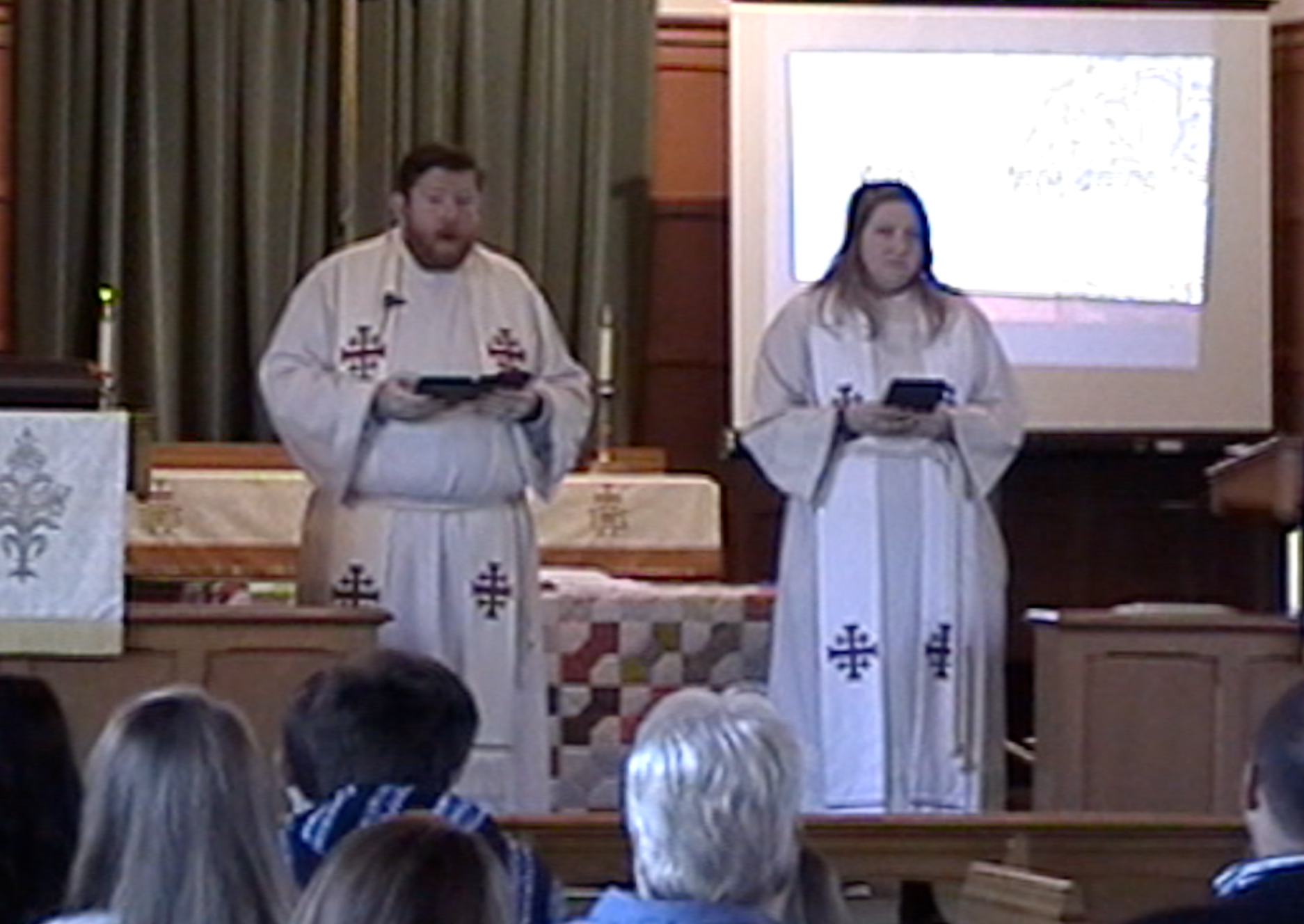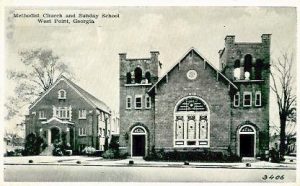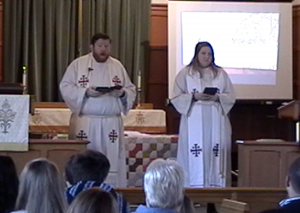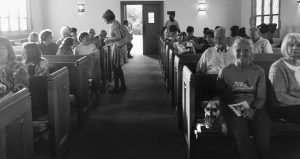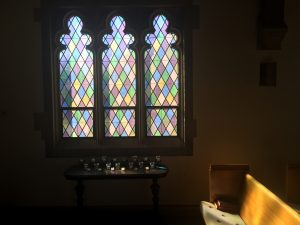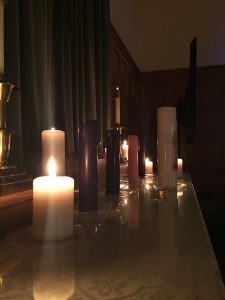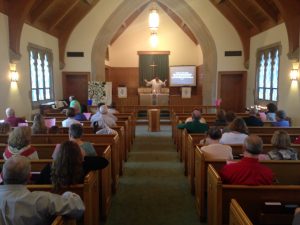PATCHWORK:
Building Christian Community Through The Introduction Of A New Worship Service As A Means Of Renewal In A Historic United Methodist Congregation
WHY DO WE NEED A NEW SERVICE?
West Point First United Methodist Church is a wonderful historic church serving as a cornerstone in West Point, Georgia since 1830. WPFUMC offers an excellent traditional worship service and Sunday school each Sunday and a variety of small group meetings and mission programs during the week. The congregation is made up of genuinely loving and faithful people. WPFUMC’s worship service and ministry programs were perfectly adapted to the environment into which it was born, but the environment has radically changed. The old social structures that were built around the textile industry have imploded as the mills closed and relocated overseas. This created a vacuum in the economy, population, culture, and spirit of the community. Twenty years later, prosperity is returning to West Point bringing new industry, a new college, and new and diverse populations. With the rapid changes all around, WPFUMC became increasingly less successful in retaining young families and connecting with the people who were moving into the area. The community building that seemed so effortless and automatic in the past suddenly became impossibly difficult.
WPFUMC wanted to do something about this issue but the solutions were not obvious. WPFUMC did not want to become or pretend to be something it was not, but it was also clear with attendance and giving trends that things could not go unchanged forever either. How could WPFUMC enter a new era of ministry without losing its unique history? What we needed was a fresh expression of our timeless faith that was powerful, authentic, and relevant. How can we introduce something new and vital without it becoming just another program or unintentionally damaging the existing worship service and programs?
Through multiple conversations, it was discovered that an entire population that would benefit from the ministries of our church were not being reached. After a six-month period of study and discernment, I presented a proposal to begin focusing on building community and renewing the church through offering a new worship experience. This motion was unanimously approved by the church’s governing body, the Administrative Council. WPFUMC could experiment with a new and different worship service that would support the already existing worship service and ministries of the church and the larger community. We slowly and carefully began putting together ideas that would become PATCHWORK, a new worship service. The next question to answer was, “what type of worship service should we offer?”
Not “Traditional” – The Old Truck
Our current opportunity to create something new required innovation and creativity; it would not be wise or helpful to offer a carbon copy or “light” version of our traditional service.
- First of all, it was generally assumed that most of the folks who wanted to attend that service already were.
- Secondly, it was decided the sanctuary would not be appropriate for the smaller crowds that typically come to a 9:00 am service and the current traditional service would not scale–down to fit in the chapel.
- Thirdly, I wanted to provide a worship service that both stood alone and complimented the traditional service so someone could choose to attend both and not be burdened or bored.
- Fourthly, while the traditional worship service at WPFUMC is excellent, Tom Long has observed that,
“when people talk about ‘traditional ‘worship’ they are really just pointing to some privileged moment in the past, some snapshot of the innovations of a previous generation.”[1]
He goes on to argue that “traditional” worship is often experienced as a
“Chevy Bel Air: it starts every time and gets you safely from here to there, but the heart never races and the spine rarely tingles.”[2]
Taking this image a step further I think of “traditional” worship as being like an worn-out old truck that still has priceless sentimental value to the owner even though it has very little appeal to anyone else.
And yet, the wisdom of John Wesley still echoed in our hearts saying, “I am for as few innovations as possible, I love the old wine the best.”[3] It is wise to honor tradition, while being weary of traditionalism.
Not “Contemporary” – The Tuner Car
On the other hand a “contemporary” service did not match the gifts, graces, or interests of our congregation. The arguments against were numerous.
- The previous attempts had not been well supported by the church or community and any attempt to revive something similar would have to overcome tremendous inertia from the very beginning.
- There is already a congregation in our area offering excellent contemporary worship.
- What most people consider “contemporary“ worship is too connected with a specific style. Don Saliers spoke to this poetically saying,
“when the Church marries the spirit of the age, she will be left a widow in the next generation.”[4]
Looking past the superficial differences, many “contemporary” services function as “traditional” services for another generation, holding just as closely to different objects of nostalgia.
If “traditional” worship is an old truck, then “contemporary” worship is a tuner car in that it is usually:
- imported from somewhere else,
- built by amateurs from a kit,
- covered in purposeless cosmetics,
- and it is modified to be LOUD
And yet, we wanted to offer a service that would speak to people with authenticity, relevance, and power. We wanted to proclaim the gospel in a way that sounds like home.
Not “Blended” – The El Camino
If “traditional” and “contemporary” worship styles were undesirable for our needs, a “blended” service would be even worse. Tom Long opines that word “blended” itself,
“tends to convey the idea of a mix-and-match approach – a dash of contemporary thrown in with a measure of traditional.”[5]
The resulting frankenstein’s monster of worship services usually exhibits all of the negative aspects of its stylistic donors with few of the virtues. Such a ghastly hybrid, an “El Camino,” service tends to be more of an uneasy truce via a compromise (wherein no one is satisfied except that everyone else is miserable too) than an authentic or intelligible manifestation of the apostolic faith.
And yet, there are many valuable elements of worship that could be claimed from both the “traditional” and “contemporary” styles. The primary flaw of the old truck, tuner car, and El Camino services might be that the focus is placed on matters of style and preference. Is there a second, third option? What if we were to start by focusing on content and then using the best of our available resources and talents, regardless of style, to faithfully embody and effectively communicate that message? Now that would be a bird of a different feather altogether!
The Turducken[6]
Again the question is, “How could an historic church do something ‘new’ and be authentic to who it is?” It was at this point that Long’s description of an alternative “Third Way”[7] sounded like “home” saying,
A classically shaped Christian worship service is formed by the biblical story…to go through the order of worship is symbolically to walk through the whole narrative of faith. The service is a metaphor constantly pointing to its referent.[8]
Here is the suggestion that worship is built on content rather than style. He goes on to confirm that such “Third Way” congregations are not “unicorns” and they do exist and exhibit a set of common characteristics that include
mystery, hospitality, drama, eclectic excellence, adaptation, missional focus, stable order of worship, joy, and charisma.[8]
This called to mind a similar list suggested by Schnase in his book, Five Practices of Fruitful Congregations.[9] What if the elements of worship could be treated like musical movements in a single composition? In his book, The Jazz of Preaching, Kirk Byron Jones said,
“the blending of carefulness and playfulness displayed by the musicians grabbed me and would not let me go,”[10] and “improvisation is spontaneity infused by preparation.”[11]
It was in the midst of this kaleidoscope of possibilities that Long mentioned Robert Webber, introducing the idea (or at least the terminology) of Ancient-Future worship.
Webber speaks in the introduction of his book, Ancient-Future Worship, of the “longing to discover the roots of the faith in the biblical and classical tradition of the church”[12] and “the search for unity in the church.”[13] He then asks the very question that PATCHWORK aspires to answer,
“How do you deliver the authentic faith and great wisdom of the past into the new cultural situation of the twenty-first century?”[14]
Webber concludes the introduction with the words,
These three matters—roots, connection, and authenticity in a changing world—will help us to maintain continuity with historic Christianity as the church moves forward. I hope what I cull from the past and then translate and adapt into the present will be beneficial to your ministry in the new cultural situation of our time.[15]
Webber defines Ancient-Future Worship as, “the common tradition of the church’s worship in Word, Table, and song, practiced faithfully and communicated clearly in every context of the world.”[16]
Like a chicken inside of a duck inside of a turkey, we could build our new service starting with a core of Wesleyan theology inside an ancient-future service of Word and Table that in turn is attuned to the “Five Practices of Fruitful Congregations” in the immediate cultural context of West Point, Georgia. I call this a “liturgical turducken.”
Wesleyan Theology – The Chicken
Discipleship Happens in Community
PATCHWORK expresses a commitment to building a new Christian community and to supporting, stimulating, and supplementing existing communities. We continually strive to reclaim, restore, and rededicate unused or underused space in our building to the service of God and neighbor. We are committed to reaching out to persons who are disconnected from Christian community due to the loss of relationships and community structures or negative experiences. We are passionate in deepening the faith of all persons in our community and to discovering, developing, and deploying the gifts of each person.
Christian Community is Ecumenical
Borrowing from the best practices of the Christian family is a large part of our identity as Methodist and one of the ways that PATCHWORK seeks to welcome people of different faith traditions, confessing that we are strongest when we are working with and learning from one another. PATCHWORK is dedicated to this “catholic spirit” and committed to work toward renewal in WPFUMC and in all the communities of faith in our area. We work to encourage all our neighboring clergy and laypersons and seek to help them to be faithful and effective in their ministry contexts.
On an average Sunday, the congregation at PATCHWORK will include people who identify as: United Methodist, Episcopalian, Baptist, Roman Catholic, or Nondenominational/Other.
Each faith tradition has something valuable to add our common worship of God. The Book of Discipline of the United Methodist Church 2008 says, “Christian unity is not an option; it is a gift to be received and expressed.”[17]
Christian Worship is Sacramental
As an ecumenical Christian community seeking to be strengthened in the love and knowledge of God, PATCHWORK will continue in the preferred Christian practice of a weekly Eucharistic celebration in the form of a service of Word and Table following the four-fold pattern of Gathering, Word, Thanksgiving, and Sending.
Ancient-Future Worship – The Duck
Structure Creates Freedom
PATCHWORK uses a set order of worship that changes very little from week to week. Ancient–Future worship naturally creates an atmosphere of holy play giving permission to experience worship in different ways and to try new spiritual practices. Rather than confining the worshiping congregation, the Ancient-Future service of Word and Table frees us from decision fatigue and from our cultural addiction to novelty while at the same time providing a context in which joyous improvisation and enchanting syncopation are both unforced and encouraged. Having earned our “chops” and “established the theme,” the church is invited into “the groove” as the congregation childlike in the trance of holy play “surrenders to the rhythm” of the Spirit and uninhibitedly joins God in the “dance” of Creation – Incarnation – Re-creation.
Five Practices of Fruitful Congregations- The Turkey
The Five Practices of Fruitful Congregations
In his book, Five Practices of Fruitful Congregations,[18] Robert Schnase identifies five practices:
- Radical Hospitality
- Passionate Worship
- Intentional Faith Development
- Risk-Taking Missions
- Extravagant Generosity
as a common denominator among churches that are thriving even as other churches around them struggle with declining attendance, membership, and outreach. These practices are recommended as powerful faithful tools to regain our missional identity and focus.
Schnase sees a universal need for congregational change to move beyond self-preservation and become fruitful amid the changing ministry needs and opportunities of our time. The five practices are meant as a template for guiding these changes, but not a rigid blueprint to be strictly followed. The five fruitful practices should be expressed in ways that complement the personality and giftedness of the local congregation.
Worship with a purpose
PATCHWORK uses the “Five Practices” as: a launch pad, touchstone, and a benchmark. As a launch pad, the “Five Practices” gave us a place to start with clear and sufficiently aspirational goals while also giving us the language to communicate and discuss those goals. With the abundance of supporting educational materials and studies available, this power tool was also very accessible for our current and future needs. As a touchstone, the “Five Practices” would be included in every worship bulletin, considered in weekly worship planning, featured in different times and in different ways as a part of seasonal themes (i.e., stewardship) and the focus of sermon series (i.e., Christian Hospitality). As a benchmark, the Five Practices would serve as a reference for measuring and evaluating our progress and defining new goals.
Identifying Goals and Metrics
I began this journey with the question, “Can the introduction of a new worship service create a Christian community and serve as a means of renewal in an historic United Methodist congregation?” Over the course of 18 months, this question has led to other interesting and complex questions and a few provisional answers.
“Renewal” is an elusive concept to define.
- In a local church setting, renewal is about positive changes in the life of a church or faith community that can be quantified and measured, but that is not all.
- Renewal, of course, is also an intangible feeling of growth, enthusiasm, and new life within a congregation, but this too is not all.
Using some of the ideas of Jane Rogers Vann, [19]
- Renewal is also a deepening of worship and the congregation’s participation in and reflection on it.
- Renewal is about an enhancement of the congregation’s fulfillment of its mission.
- Renewal is about restoring and creating life-changing relationships with a larger segment of the population.
The Numbers
Built into the conversation about church renewal is the role of statistics and metrics. What should we measure? How should we capture data? To what do we compare our results? It seems that we are at best in an awkward unspoken agreement that, “the numbers don’t count, except when they do.” Schnase expresses this idea pastorally saying:
While fruitfulness cannot be reduced to numbers, nevertheless numbers are important. Numbers represent people-each number stands for a person who is old or young, married or single, new to the faith or long-established, rich or poor, immigrant or citizen. Each is someone’s son or daughter, brother or sister, father or mother, friend and neighbor. Each is a person for whom Christ died.[20]
Vital Signs
Each week the North Georgia Conference of the United Methodist Church requires all local churches to collect and report on ten categories including: Attendance, Professions of Faith, Baptisms, Number of Small Groups, Small Group Participation, Volunteers in Mission Out Reach, Number of People Served through Outreach, Missional Giving, and Offering. WPFUMC reported an improvement in at least seven of these categories in 2016 compared to 2015 and exceeded the five year average in six categories. Not only was the decline stopped, the trend is now toward growth at almost a mirror image rate.
We also celebrated as a congregation with a Missions Report that helped us tell our renewal story with real numbers representing dollars invested and persons served. For example, in 2016 we served 2,117 meals in our Soup Kitchen ministry. By paying attention to the numbers, we were able to better communicate and celebrate the ministries of the church. By combining numbers with narrative, we have become better at seeing the growth in our community and identifying possible opportunities for the future.
The Intangibles
In addressing the complexity of the concrete experiences of congregational life, Vann says,
We perceive experiences as complex wholes, only partially organized and understood, where the interrelationships among discrete elements of an experience are as important as the elements themselves.[21]
It is possible to address the renewal within a congregation by focusing on “depth.”
- The vast majority of regular PATCHWORK attendees are actively involved in a small group ministry of WPFUMC including those who are members of other congregations.
- Most of our regular PATCHWORK attendees are actively involved in one of the missional programs of WPFUMC again this includes members of other congregations.
- Our last adult profession of faith and baptism was in a PATCHWORK service and the six most recent new members of WPFUMC were received through PATCHWORK.
We can also talk about renewal by looking at “breadth.”
- Our oldest PATCHWORK attendee has been 103 years old and our youngest are infants.
- We are becoming more representative of our community with our PATCHWORK family including persons of Anglo American, African American, Asian American, and mixed heritages.
- PATCHWORK reflects the diversity of the Christian family including persons who identify as United Methodist, Baptist (CBF), Episcopalian/Anglican, Lutheran (ELCA), Presbyterian (PCUSA), Roman Catholic, Non-Denominational (CC), and Post-Christian seekers.
First Fruits
PATCHWORK is always a work in progress. We intend to continue to improve as both a worship service and as a laboratory for innovation in our church.
- We are already seeing fruits of liturgical renewal in the traditional services. We have celebrated communion weekly for the seasons of Advent and Lent and are currently including more of the lectionary readings in our service. You can’t put new wine into old wine skins, but when the new wine has had a little time and space to mature you can!
You can hear some of our PATCHWORK family share their descriptions of our service here
Next Steps
PATCHWORK is always a work in progress. We intend to continue to improve as both a worship service and as a laboratory for innovation in our church.
- We will continue to use PATCHWORK as a training ground for people to explore their gifts and make mistakes.
- We will continue to use PATCHWORK as a supplement to the Traditional service for those who want to go a little deeper.
- We are considering the possibilities for more special services and daily or weekly prayer opportunities.
- I would like to continue to study Church Renewal and help other congregations discover their “PATCHWORK.”
- I am currently in a period of discernment before taking vows for the Order of Saint Luke, in no small part as a result of my PATCHWORK journey.
PATCHWORK continues to demonstrate that it is possible to build Christian community through the introduction of a new worship service as a means of renewal in an historic United Methodist congregation. Thanks be to God!
[1] Thomas G. Long, Beyond the Worship Wars: Building Vital and Faithful Worship, (Bethesda: The Alban Institute, 2001), 3.
[2] Ibid., 11.
[3] W. Stephen Gunter and John Wesley, The Quotable Mr. Wesley (Candler School of Theology, 1999), 43.
[4] E. Byron Anderson and Bruce T. Morrill SJ, eds., Liturgy and the Moral Self: Humanity at Full Stretch Before God (Collegeville: Pueblo Books, 1998), 33.
[5] Long, Beyond the Worship Wars, 12.
[6] “Turducken is a dish consisting of a deboned chicken stuffed into a deboned duck, further stuffed into a deboned turkey.” “Turducken,” Wikipedia, last modified March 5, 2017, accessed March 13, 2017, http://en.m.wikipedia.org/wiki/Turducken.
[7] Long, Beyond the Worship Wars, 9.
[8] Ibid., 10.
[9] Ibid., 13.
[10] Kirk Byron Jones, The Jazz of Preaching: How to Preach with Great Freedom and Joy (Nashville: Abingdon Press, 2004). 64.
[11] Ibid., 85.
[12] Robert E. Webber and John Wilvliet, Ancient-Future Worship (Ancient-Future): Proclaiming and Enacting God’s Narrative (Baker Books, 2008), 19.
[13] Ibid.
[14] Ibid., 20.
[15] Ibid.
[16] Ibid., 68.
[17] The Book of Discipline of the United Methodist Church 2008 (Nashville: Abingdon Press, 2009), 84.
[18] Robert Schnase, Five Practices of Fruitful Congregations (Nashville: Abingdon Press, 2007).
[19] Jane Rogers Vann, Gathered before God: Worship-Centered Church Renewal, (Louisville: Westminster John Knox Press, 2004), 3.
[20] Robert Schnase, Five Practices of Fruitful Congregations (Nashville: Abingdon Press, 2007), 133.
[21] Jane Rogers Vann, Gathered before God: Worship-Centered Church Renewal, (Louisville: Westminster John Knox Press, 2004), 43.
Save
